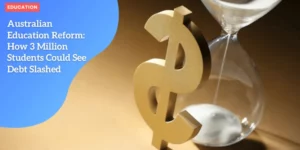Australia’s Education Revolution: Student Debt Cuts and Free TAFE Places Announced

Anúncios
Major Student Debt Relief Initiative
The Australian government has announced a groundbreaking initiative designed to ease financial burdens for millions of former students across the nation.
With rising education costs and growing economic pressures, the intention behind this initiative is to provide significant relief and improve the financial situation for a substantial segment of the population.
Comprehensive Debt Reduction
The government plans to cut student loan debt by 20%, which amounts to a total reduction of A$16 billion.
This ambitious plan means that approximately three million Australians will benefit, significantly easing their financial load.
For individuals, this translates to a reduction in the average student loan from A$27,600 by A$5,520.
By alleviating such a considerable amount of student debt, the government aims to give a much-needed financial respite to many former students.
Wide-Ranging Impact
This initiative is expected to have a transformative impact on the lives of those with student loans, who have been struggling to keep up with repayments in the face of high living costs and economic uncertainty.
The direct financial benefits will enable people to redirect resources towards other essential expenses, thereby improving overall quality of life.
 Education revolution
Education revolution
Implementation Details
The student debt relief measures will come into effect starting June 1, 2025. These aren’t just one-off concessions;
the government has a broader strategy in place.
Plans are also in motion to lower annual repayment rates for student loans and raise the income thresholds for the commencement of repayments.
Such a strategic outline will ensure that the relief continues to benefit graduates for years to come.
The timeline set for June 2025 gives students and financial planners adequate time to adapt to the new policies, ensuring a smooth transition to the new repayment system.
Aimed at a Brighter Future
“This will help everyone with a student debt right now, whilst we work hard to deliver a better deal for every student in the years ahead,” stated Prime Minister Anthony Albanese during the announcement.
This new initiative is a clear testament to the government’s commitment to long-term educational reforms.
Despite the present challenges, these measures form part of a broader initiative to make education more accessible and financially manageable for all Australians.
Continuing these efforts includes not only immediate financial relief but promises of sustained support and improvement in educational infrastructure.
Implementation and Timeline
The Australian government has announced that the student debt relief measures will officially take effect from June 1, 2025.
This significant date marks the commencement of several critical changes designed to alleviate the financial burden on millions of Australians.
Effective Date: June 1, 2025
Beginning June 1, 2025, the government’s initiative to reduce student loan debt by 20% will come into play.
This equates to an overall reduction of A$16 billion, benefiting around three million Australians.
For an average student loan of A$27,600, this means a reduction of A$5,520, easing the financial loads for many graduates.
Lower Annual Repayment Rates
Additionally, the government plans to lower the annual repayment rates for student loans.
By reducing the proportion of income that goes towards repaying student loans each year, graduates will have more disposable income to cover their daily expenses and save for the future.
This move is aimed at providing long-term financial relief and ensuring that graduates are not disproportionately burdened by their educational investments.
Raising Income Thresholds
Another significant aspect of the plan is to raise the income thresholds for loan repayment commencement.
This means that graduates will start repaying their student loans only once they reach a higher income level.
Adjusting the threshold upward ensures that individuals with lower incomes won’t struggle to make loan repayments, allowing them to achieve greater financial stability before taking on debt repayments.
Transitioning to the next part of the government’s broad economic strategy, which includes these debt relief measures, emphasizes their holistic approach to alleviating cost of living pressures and enhancing overall economic stability for Australians.
Free TAFE Education Promise
Labor Party’s Pledge
The Labor party has made an ambitious promise aimed at revolutionizing Australia’s education system – the introduction of 100,000 free annual places at Technical and Further Education (TAFE) institutes.
Should the Labor party secure re-election in 2025, this initiative will be implemented to broaden educational opportunities for all Australians.
By alleviating the financial burden associated with TAFE studies, the government hopes to make education more accessible to many, fostering a knowledgeable and skillful workforce.
Education Accessibility For All
The core of this initiative lies in building better accessibility to education. Education is vital for personal and professional development, yet financial constraints often impede students from pursuing their desired courses.
This pledge ensures that more students, particularly those from low-income backgrounds, have an opportunity to further their education and enhance their skills without the stress of tuition fees.
The promise also aligns with the government’s broader objective to bridge the socio-economic gap and promote equal educational opportunities across the country.
Contingency on Re-election
The feasibility of this initiative hinges on the Labor party’s success in the upcoming 2025 federal elections.
The party’s emphasis on educational reform and economic relief is expected to resonate well with the electorate, especially in light of current cost of living pressures exacerbated by high inflation.
This pledge reflects the party’s long-term vision of a progressive nation where education is a right, not a privilege.
By securing a majority in the 2025 elections, the Labor party aims to transform this vision into reality.
| Benefit | Before | After (With Free TAFE) |
|---|---|---|
| 👩🏫 Skilled Workforce | Limited access to education and skills training | Increased access to quality education, leading to a more skilled workforce |
| 💡 Economic Growth | Stagnant economic growth due to limited workforce skills | Stimulated economic growth through a highly educated and skilled workforce |
| 🌍 Social Mobility | Barriers to education and career progression | Improved social mobility through accessible education for all |
| 🇦🇺 Economic Relief | Limited financial stability and opportunities for lower-income individuals | Enhanced financial stability through accessible education programs, fostering long-term well-being |
Broader Cost of Living Relief Strategy
The Australian government’s recent student debt relief initiative is just one element of a larger strategy to ease the financial burdens faced by its citizens.
Recognizing the broad spectrum of cost-of-living pressures, this multifaceted approach aims to provide comprehensive economic support that addresses key areas of concern.
Reducing Medicine Costs
One significant component of this strategy is the initiative to reduce medicine costs.
With healthcare expenses being a considerable part of many household budgets, lowering the cost of essential medicines can have an immediate and positive impact on families across Australia.
By making healthcare more affordable, the government aims to ensure that all Australians have access to the medications they need without the stress of financial strain.
This measure is not only about immediate financial relief but also about long-term health outcomes, as more affordable pharmaceuticals can lead to better medication adherence and overall public health improvements.
Enhanced Rent Assistance
Another critical aspect of the broader cost of living relief strategy is the enhancement of rent assistance programs.
Housing costs have been a persistent issue in major Australian cities, and rising rents can significantly impact the disposable income of many individuals and families.
The government’s plan to boost rent assistance is designed to offer more substantial aid to those struggling with high housing expenses.
By increasing the support available, the initiative aims to keep housing affordable, ensuring that fewer Australians are at risk of housing insecurity.
Holistic Financial Relief
Combining these measures with the student debt relief initiative underscores the government’s commitment to addressing economic challenges from multiple angles.
By targeting education, healthcare, and housing, the strategy seeks to offer a well-rounded approach to mitigating the high cost of living.
These efforts reflect the recognition that financial stressors are interconnected and that comprehensive solutions are necessary to provide meaningful relief.
The timing of these initiatives is also strategic, aligning with the upcoming federal election. This approach demonstrates the Labor government’s dedication to both immediate economic relief and long-term reforms.
As these measures take effect, they will provide significant support to millions of Australians, aiming to create a more financially secure and accessible society.
These efforts are part of a broader vision for economic and social reform, setting the stage for further improvements and initiatives that will continue to build a better future for all Australians.
Political and Economic Impact
The Australian government’s latest initiative to cut student debt by 20%, amounting to A$16 billion, is a strategic move designed to ease the growing cost of living pressures amid high inflation.
By offering substantial debt relief to around three million Australians, the initiative aims to provide immediate financial relief to those burdened by student loans.
This step underscores the government’s commitment to economic reform and educational investment.
Addressing Inflation and Living Costs
High inflation has been a central concern for Australians, affecting everything from groceries to housing.
The student debt relief initiative forms part of a broader strategy to mitigate these pressures.
Lowering the financial obligations of former students helps increase their disposable income, enabling them to better manage other living expenses.
By reducing the average student loan from A$27,600 to A$22,080, Australians will have more breathing room in their budgets, ultimately alleviating some economic stress.
Strategic Timing with Federal Election
The timing of this announcement is particularly significant, coming as it does ahead of the next federal election.
With the center-left Labor government aiming to secure re-election, this initiative demonstrates their proactive approach to addressing voters’ economic concerns.
The promise of reduced student debt and the prospect of 100,000 free TAFE places annually if re-elected present a compelling vision for the future, aimed at garnering support from younger demographics and their families who are directly impacted by educational costs.
Commitment to Long-Term Economic Relief
Beyond immediate financial relief, this initiative signals a long-term commitment to economic reform.
Lower annual repayment rates and higher income thresholds for loan repayments mean that graduates can enter the workforce without the looming pressure of debt, allowing them to contribute to the economy more effectively.
This, along with other measures such as reducing medicine costs and enhancing rent assistance, forms a comprehensive approach to create a more financially secure society.
The government’s focus on these intersecting issues of education and economic stability highlights a holistic vision for Australia’s future.
By tackling both immediate and long-term financial challenges, the Labor government is aiming to build a more resilient and equitable economy for all Australians.







